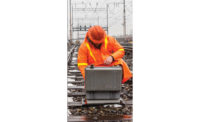U.S. railroads are making gains toward meeting the yearend deadline for having automatic train control systems in place, but nine commuter-rail lines remain “at risk” of failing to hit that target, the Federal Railroad Administration says.
To help railroads with their Positive Train Control (PTC) push, FRA also has awarded $203.7 million in grants for such items as wayside signals and in-locomotive and fiber-optic communications systems.
FRA’s latest quarterly update on Positive Train Control installation, released on Aug. 23, indicates that, as of June 30, 15 railroads have installed 100% of the equipment needed for operating the system. Another 12 carriers have 85% to 99% of the hardware in place.
In all, 41 railroads are covered by the PTC mandate.
In general, freight railroads continue to achieved more progress, reporting PTC in operation on 66% of their total route-miles, up from 37% as of June 30, 2017.
Commuter lines have lagged, with systems in place on 24% of their mileage, up just one percentage point over the year-earlier level.
In fact, nine commuter railroads are still at risk of missing the yearend target, FRA reported. That’s an improvement over the approximately one dozen in that category as of March 31.
The nine are responsible for 1.1% of the total route-mileage subject to the PTC mandate.
The nine include the busy New Jersey Transit network, which had operating PTC on none of its 317 route-miles as of June 30. NJ Transit also had only 26% of its locomotives equipped with PTC devices.
Nancy J. Snyder, an NJ Transit spokesperson, said via email that “PTC installation remains our highest priority.” She said the agency has “made substantial progress in the last six months,” completing 60% of the FRA milestones, up from 12%.
Snyder says NJ Transit is continuing to work to meet the FRA requirements by the end of December but adds that “we have our work cut out for us over the next four months.”
FRA Administrator Ronald L. Batory said in a statement, “While we are seeing progress among a majority of railroads, we want to see everyone meet their requirements.”
If railroads cannot comply with FRA requirements by Dec. 31, they may be able to qualify for an extension, or “alternative schedule,” if they meet six conditions. One condition is having all PTC hardware installed.
In any case, an extension cannot carry beyond Dec. 31, 2020.
PTC is a combination of wayside and in-locomotive equipment that aims to prevent derailments and excessive train speed. The National Transportation Safety Board has for years recommended that railroads install the systems to avoid accidents.
FRA’s $203.7 million in PTC grants, also announced on Aug. 23, are divided among 28 projects in 15 states.
The largest grant is an up-to $29.4-million award to the Rio Metro Regional Transit District in New Mexico—one of the at-risk railroads—to help fully implement PTC on 96 miles between Belen and Santa Fe.
Other big grants include up to $23 million to the Metra system in Illinois for fiber optic systems on the Rock Island and South West Service lines; and up to $20 million to the Massachusetts Bay Transportation Authority to help complete implementation of a speed-enforcement system, as well as system testing.
FRA also said it will publish a notice “in the coming days” seeking applications for another $46 million in PTC grants.
Correction: On 8/24/18 FRA issued a correction, saying that nine at-risk railroads account for about 1.1% of total route-miles subject to PTC requirements, not 11% as it had said in an earlier press release. ENR's story reflects the correction.



Post a comment to this article
Report Abusive Comment